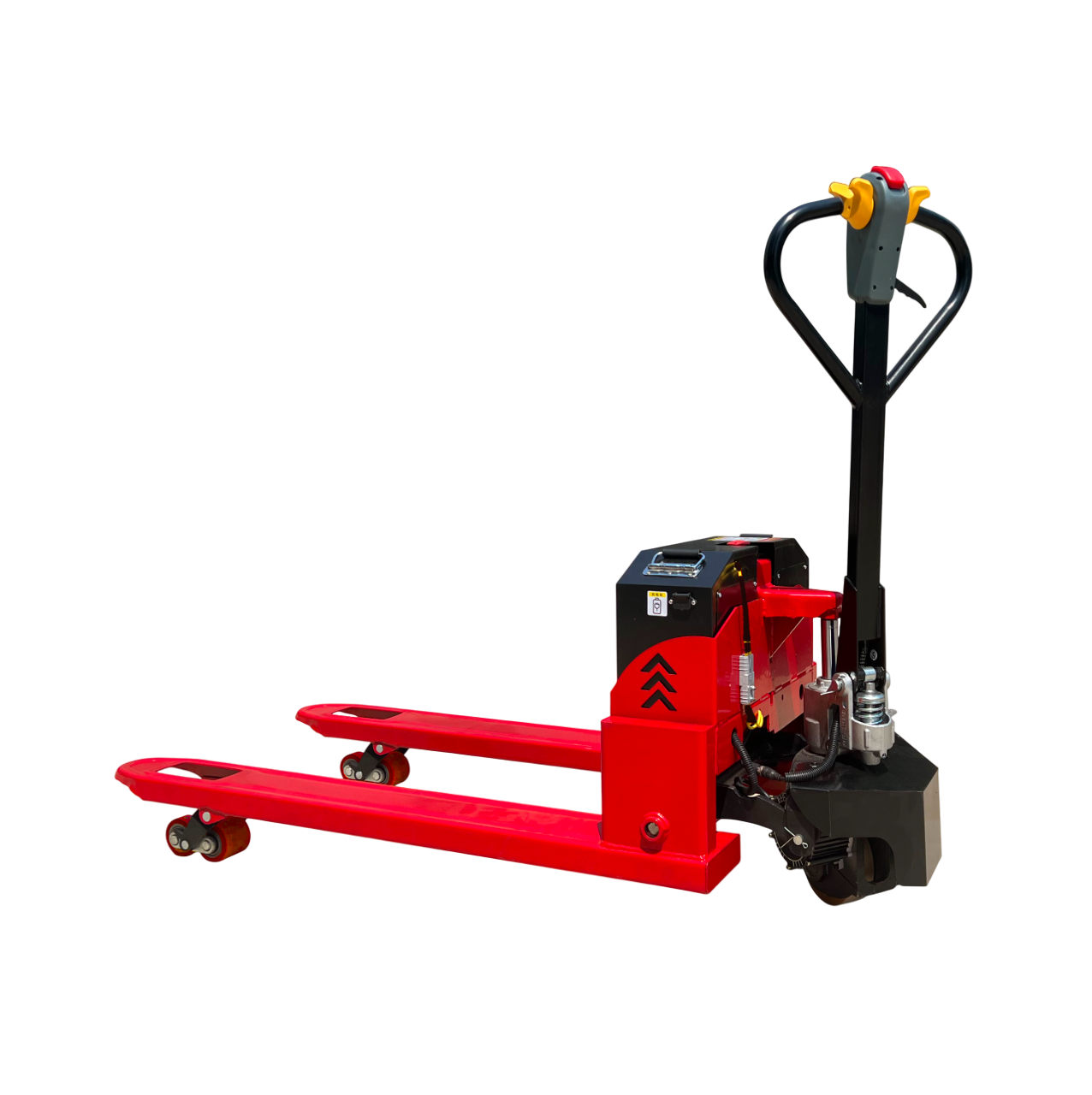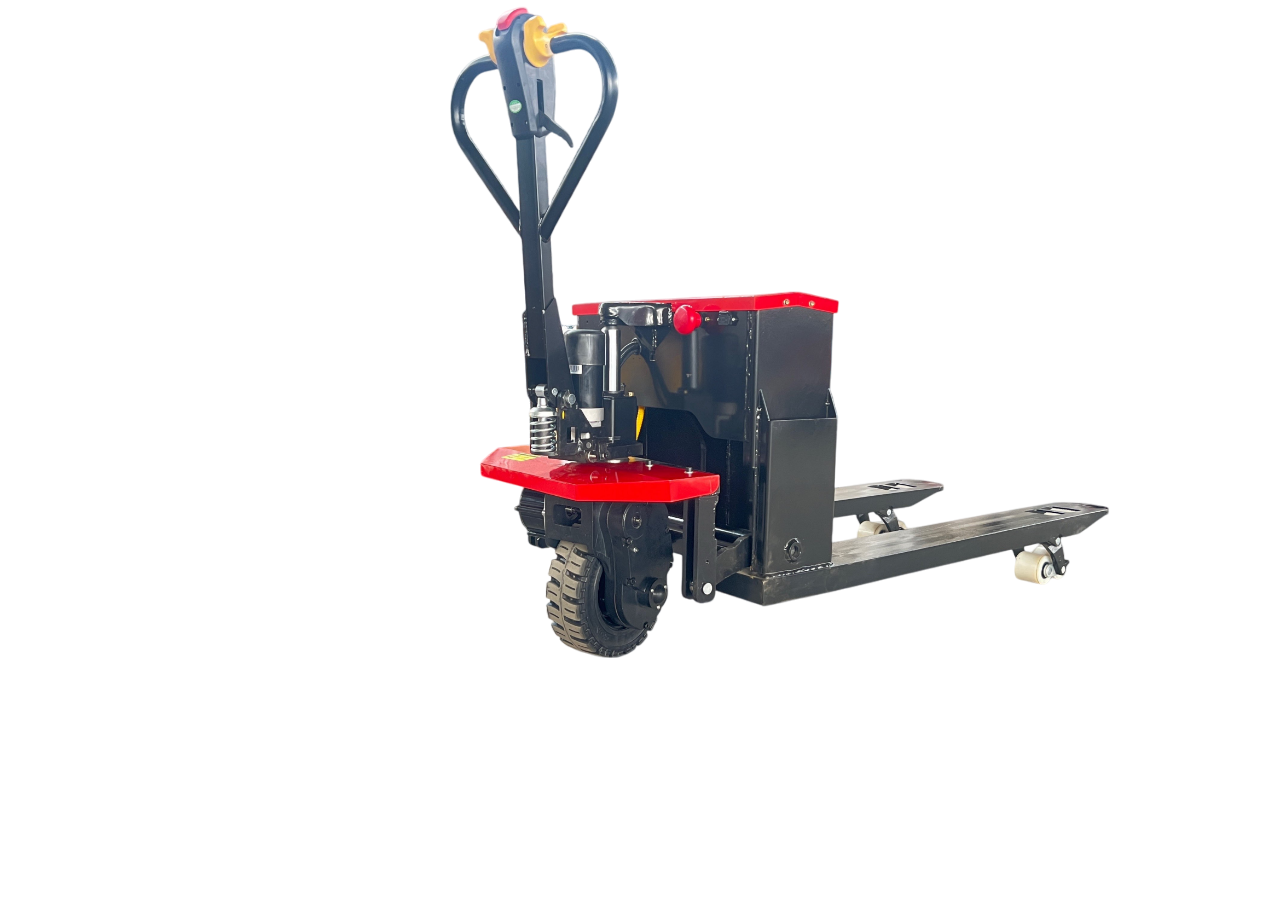An electric pallet cart is a versatile and efficient material handling device designed to transport palletized goods over short to medium distances using electric power, offering a practical alternative to manual carts and forklifts. It is widely used in warehouses, factories, retail stores, and logistics centers, providing a cost-effective solution for moving heavy loads with minimal effort. With its compact design, easy operation, and zero emissions, it is ideal for indoor use, particularly in environments where noise and air quality are priorities. The construction of an electric pallet cart is focused on durability and functionality. It features a sturdy steel frame that can support loads ranging from 500 kg to 3,000 kg, depending on the model. The frame is designed to withstand daily use and heavy loads, ensuring long-term reliability. The platform or forks—depending on the cart type—are made from high-grade steel to securely hold pallets or other goods during transport. Fork-style electric pallet carts have two forks that slide under pallets, while platform-style carts have a flat surface for placing non-palletized loads, offering flexibility for different types of cargo. The power source of an electric pallet cart is a rechargeable battery, typically lead-acid or lithium-ion. Lithium-ion batteries are preferred for their faster charging, longer lifespan, and lighter weight, making the cart more agile and reducing charging downtime. The battery is integrated into the cart’s design, often located beneath the platform or within the frame, contributing to balanced weight distribution and stability. Most electric pallet carts are equipped with a battery level indicator, allowing operators to monitor power usage and plan recharges. Some models support opportunity charging, enabling quick recharges during breaks to extend operational time, which is particularly useful for multi-shift operations. Operating an electric pallet cart is simple and user-friendly, making it accessible to operators with minimal training. It is controlled via a handle or control panel that includes buttons for moving forward, backward, and, in some models, adjusting the speed. The handle is ergonomically designed with a comfortable grip to reduce fatigue during extended use. Many carts feature variable speed control, allowing operators to adjust their speed based on the environment—slower in crowded areas and faster in open spaces. The cart comes to a stop when the control handle is released, thanks to an automatic braking system that ensures safety. Maneuverability is a standout feature of an electric pallet cart. Its compact size and tight turning radius allow it to navigate through narrow aisles, doorways, and tight corners, making it suitable for use in small warehouses and retail backrooms. The wheels are made from durable materials such as polyurethane or rubber, which provide a smooth ride over concrete floors, minimize noise, and prevent damage to indoor surfaces. This makes the electric pallet cart ideal for use in noise-sensitive environments like offices, schools, and hospitals, where quiet operation is essential. Safety is a key consideration in the design of an electric pallet cart. The automatic braking system prevents unintended movement when the control handle is released, reducing the risk of collisions. Many models include a horn and flashing lights to alert pedestrians and other workers to the cart’s presence, enhancing safety in busy areas. The platform or forks are designed to securely hold loads, with some featuring retaining lips or straps to prevent items from sliding off during transport. The low center of gravity and stable frame minimize the risk of tipping, even when carrying uneven loads. Additionally, the cart’s speed is often limited to ensure safe operation in pedestrian-heavy areas. Maintenance requirements for an electric pallet cart are minimal, contributing to its cost-effectiveness and long lifespan. Regular maintenance tasks include checking the battery connections for corrosion, inspecting the tires for wear, and lubricating moving parts such as wheel bearings and hinges. The electric motor and controller are designed for durability, requiring little more than periodic visual inspections. Lithium-ion batteries require no maintenance beyond regular charging, while lead-acid batteries need occasional water refills to maintain proper electrolyte levels. Cleaning the cart regularly to remove dirt and debris helps prevent rust and ensures optimal performance. This low maintenance profile reduces downtime and operational costs, making the electric pallet cart a practical choice for businesses. The applications of an electric pallet cart are diverse, spanning various industries. In retail, it is used to move inventory from storage rooms to sales floors, allowing staff to restock shelves efficiently without disrupting customers. In manufacturing facilities, it transports raw materials to production lines and finished products to storage or shipping areas, streamlining production workflows. In healthcare, it moves medical supplies, equipment, and linens between departments, ensuring timely delivery in busy hospitals. It is also useful in libraries, museums, and event venues for transporting heavy items such as books, exhibits, and equipment. The electric pallet cart’s ability to operate in confined spaces and its quiet operation make it suitable for a wide range of indoor environments. Cost-effectiveness is a significant advantage of an electric pallet cart. Its initial purchase price is lower than that of a full-sized electric forklift, making it accessible to small businesses and startups. The lower operating costs compared to manual carts—due to reduced labor requirements—and the elimination of fuel costs (as it runs on electricity) further enhance its affordability. The electric pallet cart reduces physical strain on workers, lowering the risk of workplace injuries and associated costs such as medical expenses and lost productivity. Its durability and low maintenance requirements ensure long-term value, providing a high return on investment. In conclusion, an electric pallet cart is a practical, efficient, and safe material handling solution for businesses looking to streamline their operations. Its compact design, maneuverability, and electric power make it ideal for indoor use, while its low maintenance requirements and cost-effectiveness make it a smart investment. Whether used in a retail store, warehouse, or healthcare facility, the electric pallet cart enhances productivity, reduces labor costs, and creates a safer, quieter work environment, proving its value as an essential piece of material handling equipment.


